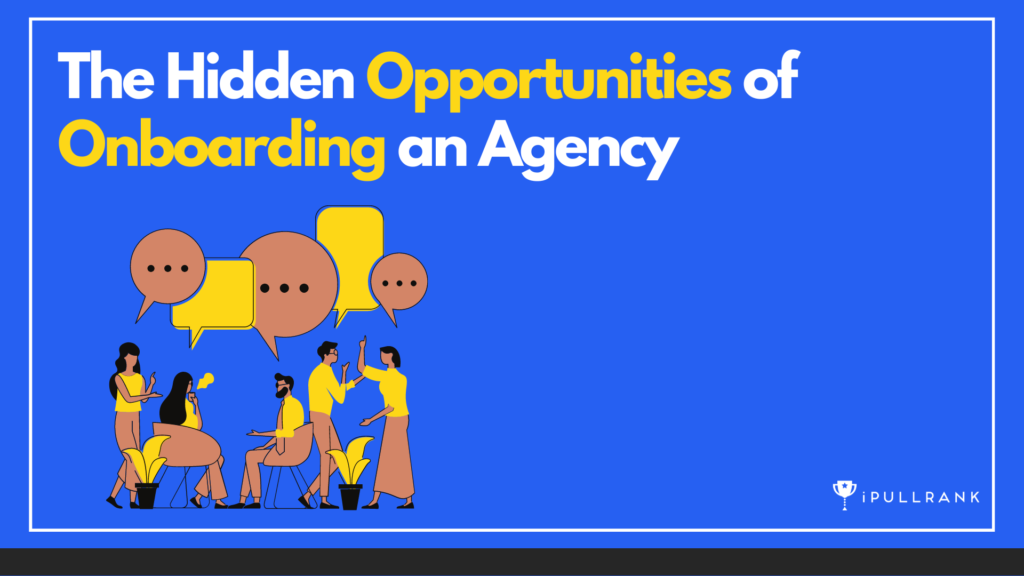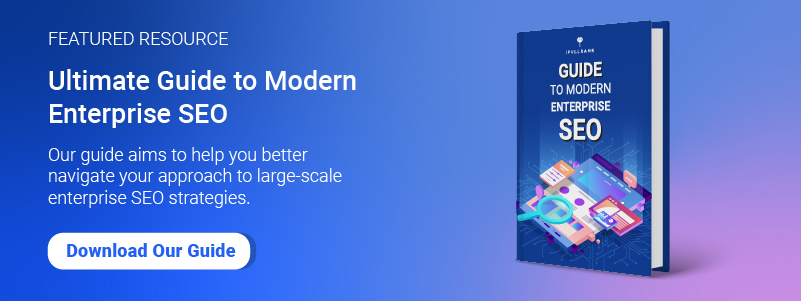Agencies don’t get it.
They don’t know your business as you do. Agency onboarding is pointless; It would take too much time and effort to bring an agency up to speed.
It’s not a viable strategy.
This is the objection, isn’t it? You don’t have the time to provide an agency with the handholding they need to do their jobs.
Here’s the thing.
Your agency doesn’t need you as much as you think they do. Don’t misunderstand, your agency needs you to provide specific details.
They don’t need you to babysit them.
You’re about to find out why.
The perceived challenges of agency onboarding
What’s the enterprise perception of agency onboarding? Well, it’s viewed as slow, difficult, and incomplete.
Why is that?
Well, let’s take a look.
#1. A lack of speed
Agencies require specific data, access to company resources, and access to key stakeholders, influencers, and support teams.
All of this takes time.
If you’re part of an enterprise, you’re well acquainted with the chain of approvals system. The chain of approval is supposed to function as a sort of checks and balances, ensuring that decisions are made by the right people at the right time.
How is this approvals culture used?
I’m sure you already know. Approval culture is a political tool that’s used to delay or deny responsibility. As I mentioned in my previous post, “Much of the political footwork in an enterprise revolves around trying to avoid ownership.”
Approval culture is a search for the decision-maker or team that extends approval and accepts responsibility.
Poor leaders delay or deny this decision to minimize responsibility (and consequences).
It’s sad but true.
No one wants to accept responsibility or extend approval when there’s risk involved.
#2. An unwillingness to share information
Why are enterprises unwilling to share their information? There are two main causes for this.
- Data silos: This is data that’s stored or controlled by a specific team, group, or department. Various groups store their data under lock and key. This becomes a problem if, for example, the agency needs data from the SEO and PPC teams, but neither group is willing to cooperate or share access to their siloed data.
- Turf wars: Cambridge defines a turf war as “a situation in which two or more people or organizations are in competition over an area of business or other activity.” From an agency standpoint, this could be an organizational battle for control to determine which team takes point with the agency or who has access to what.
Various departments maintain control over a repository of information they use to do their jobs. These data silos are typically off-limits to outsiders (e.g., other people, teams, or depts).
Here’s the worst part. The data silos in your organization grow as the quantity and diversity of the information you manage increases. This makes turf wars and internal politics worse.
So what?
How does this affect your agency?
They’re viewed by everyone else as a member of your team. Nothing gets done if your agency fails to establish its firm as an objective third party.
What can you do?
Is there anything that can be done to address these issues?
The role self-audits play in the onboarding process
What does your agency need from you?
Do you know?
Believe it or not, many organizations don’t know what their agency needs, even if they’ve worked with an agency before! These agencies understand SEO, PPC, email, or content marketing. They know their audience; they may even be aware of the overall performance of their campaign.
It’s not enough.
If you want to mitigate the onboarding challenges ahead of your agency, you’ll need to take action; I’m talking about pre-onboarding, onboarding, and self-audits.
Where do you start? You start with your thematic goal.
What’s that?
Patrick Lencioni outlines the strategies for overcoming these challenges in his book, Silos, Politics, and Turf Wars.
They are as follows:
- A thematic goal: “A single, qualitative focus that’s shared by the entire leadership team — and ultimately the entire organization. It applies for a specific timeframe and typically uses verbs like — improve, reduce, increase, grow, change, etc.” No numbers, no quantitative details. That comes later.
- A set of defining objectives: These objectives are also qualitative and tied to a specific timeframe. There are two types of objectives. (a.) Defining objectives that further explain the thematic goal and (b.) Standard operating objectives like customer satisfaction, expenses, productivity, quality, etc.
- Key metrics: This comes into play once the legwork for the thematic goal and objectives are complete. These metrics are quantitative, but they should be relevant. It may be tempting to start here, don’t. Metrics can’t provide context by themselves.
What does this look like?
- Situation: Sales are on the decline for a national fast-food chain. More and more of their customers are choosing healthier options like salads, wraps, and freshly prepared meals.
- Thematic goal: Rebrand/reposition the company for the health-conscious consumer.
- Defining objectives: Rebrand the company nationally, revamp the menu, switch to organic ingredients, create farm-to-table partnerships, etc.
- Standard operating objectives: Increase revenues/maintain profit margins, minimize employee turnover and pass all health inspections.
- Time frame: 24 months
It’s certainly ideal if you can do this across the organization, but sometimes you can’t. What if you can’t get everyone in the organization on board? What if you don’t have the time to pursue that goal?
You scale down.
You focus on your department, team, or group (or the people you need) instead of the organization at large. This is essential because it brings everyone involved on the same page. Think of this as a kind of pre-onboarding process.
What impact does this have?
It minimizes the onboarding challenges we discussed earlier. When you ask for help, you’re far more likely to get it.
At this point, you’re ready.
You can begin the self-audit process.
Step 1: A self-audit of all relevant internal documentation:
You’ll want to gather the following internal documentation your agency will need ahead of time. If your agency is expected to make site-wide changes, you’ll want to make sure you have site-wide access ahead of time.
- Credentials and access data
- Goals and objectives
- KPIs and metrics
- Performance benchmarks (reports, analytics, tools, etc.)
- Audience/customer research
- Value proposition
- Competitive and positioning research
- Tech stack (website, hosting, CMS, tools, etc.)
- Performance history (via previous agencies, contractors, freelancers, etc.)
- Brand, style, and content guides
- Content guidelines (a governance plan for writing style and tone)
- Content brief, strategy documents, and engineering plan
- Editorial calendar
- Project plans
You’ll also want to gather the right assets (e.g., images, graphics, details, content, whitepapers, etc.) ahead of time.
Step 2: A self-audit showing how information is organized
Your agency will need to know how to work with your data.
- How is your data organized? (e.g., order of location, chronological order, deductive/inductive order, inverted pyramid, problem/solution, priority sequence)
- Does your agency need to follow a specific set of rules or processes to work with your data?
- What sort of information workflow does your organization use?
- Are there specific rules or naming conventions that need to be followed?
- Where can agencies find the information they need?
- What is your organization’s data governance policy?
- Which tools (and versions) should be used to access, use, or maintain data?
If these details vary based on the team, group, department, or locale, you’ll want to inform your agency ahead of time, so they avoid making any mistakes.
Step 3: A self-audit of the project efficacy/goals
Some enterprises fail by design.
Rita Gunther McGrath outlines this in her article for the Harvard Business Review.
She writes: “When I ask executives how effective their organizations are at learning from failure, on a scale of one to 10, I often get a sheepish “Two—or maybe three” in response. As this suggests, most organizations are profoundly biased against failure and make no systematic effort to study it. Executives hide mistakes or pretend they were always part of the master plan. Failures become undiscussable, and people grow so afraid of hurting their career prospects that they eventually stop taking risks.”
This is a problem.
Your agency needs to know what they’re walking into. Are they picking up the pieces from a previous (undiscussed) failure? Is it taboo for agency reps to ask questions about specific topics?
The answer is important.
A self-audit of your project or campaign is essential. If you’re able to have a frank conversation about the details that took place, you’ll have what you need to help your agency.
Help them how?
An awareness of the failures of past initiatives gives you the ability to determine what failure or success will look like before your kick-off meeting with your agency.
How do you determine project efficacy?
This varies depending on your industry, organization, size, and other factors. A few simple criteria you can use to help your agency get started would be:
- Project outcomes: Increase landing page quality scores by 15% or add 250 high-traffic conversion keywords to your SEO campaigns.
- Performance goals: Achieve a 15% lift in conversions (minimum) via CRO.Decrease per lead costs by a minimum of 17% across all projects.
If you’re aware of the goals and objectives you have in place, it’s going to be difficult for your agency to achieve consistent results.
What about your agency?
Are there hidden opportunities your agency can use for onboarding?
Let’s take a look.
The value of agency opportunities
Have you given your agency the chance to expand its role? This isn’t a common approach, but it’s a worthwhile endeavor. If your agency has the opportunity to ‘audition,’ you may find that they can produce huge, career-making gains.
Here’s how you do it.
Step 1: Agency discovery
If you’ve done your homework, you know your organization’s goals, objectives, KPIs, and metrics. You know what needs to be done, and you have a pretty good idea of the steps you’ll need to take to accomplish these items.
Or do you?
Companies hire agencies to fix known/unknowns – things you know you don’t know how to accomplish (i.e., we need to increase lead flow by a minimum of 23%, how do we achieve this?). Your organization is filled with these problems. They’re important, they need to be addressed, and they’ll create gains for your company.
But there’s something more important than these known/unknowns.
Unknown/unknowns.
These are details or organization doesn’t know that it does not know.
What kind of details?
- This customer segment hates your company.
- This is why you have a growing segment of detractors.
- Two percent of your SEO keywords produce 96% of your organic search traffic. But you don’t know which ones.
- 1/3 of your PPC landing pages produce blank pages or 404 errors, inflating expenses by 157%.
- You may lose a large segment of your organic search traffic due to Google’s most recent update.
See what I mean?
Imagine that you’re disinterested and unaware of these problems. Your agency can see them, but you are completely focused on the known/unknowns. The problems you’re aware of that you feel need to be addressed now.
What would this do to your company?
Step 2: Agency discovery (more opportunities)
Your agency has the untapped ability to identify known/unknowns, unknown/knowns, and unknown/unknowns. The more blind spots your agency consistently identifies (e.g., financial, performance, and outcome blind spots) via your Johari Window, the more opportunities you’ll receive.
What kind of opportunities can your agency produce?
- Increase revenue (e.g., average order values, repeat sales)
- Increase sales (e.g., upsell, cross-sell, down-sell)
- Increase profit (selling more new/more products)
- Decrease expenses (e.g., per lead costs, ad costs)
- Eliminate financial leakage (e.g., phantom expenses, billable leakage)
These details are helpful, but only if your agency has the opportunity to act on them.
Step 3: Agency structured information delivery
Agencies understand the information needs of your organization.
What does this mean?
Your agency knows how to speak to the various people in your organization. They provide them with detailed reports that are structured in the right format for the right people.
Who are the right people?
- Stakeholders: They want just the facts; they’re looking for concise, bite-sized actionable information to help them make important decisions.
- Decision-makers: They’re skimmers at heart. They skim through the data your agency provides. But they choose to dig deep if stopped by roles (e.g., influencers, blockers, gatekeepers, stakeholders, etc.).
- Executive sponsor: These are non-decision-makers who act as champions or blockers depending on their role.
- Influencers: They’re highly knowledgeable (generalists or specialists) professionals who hold a significant amount of sway with decision-makers and stakeholders. An influencer who’s working against your interests is known as a…
- Blockers: These people are on the opposite side of the issue; this is a natural consequence of data silos and turf wars.
- Champions: They’re the opposite of the blocker. They’re on your side, and they’re eager to fight for your cause or role.
- Compliance: These are the people who are responsible for the terms and conditions of your contract. This could be in-house counsel or a compliance officer. People in this role often behave as blockers to the unprepared. If your enterprise is interested in bringing an agency onboard, you’ll want to identify the legal roadblocks ahead of time.
How do these roles impact information delivery?
- Reporting: Agencies provide each role (see above) with properly formatted reports; they address various reporting styles, ensuring everyone receives the data they need in the format required.
- Dashboards: These are typically web-based reports (e.g., lead scoring, analytics, research tools) that highlight specific data points. They use delayed or real-time data to visually display key metrics.
- Ad hoc query: Customized, self-service reporting that allows stakeholders to ask their data questions without getting IT involved.
What does this mean for information delivery?
Everyone gets the data they need, the way they need it when they need it. Compliance doesn’t care about performance data; they care about the terms and conditions. Stakeholders receive the information they need to make actionable decisions. Agencies provide each role with the data they need in the format it’s needed.
Step 4: Agency accountability (the value of an external project manager)
There’s a significant benefit that comes with agencies.
External project managers.
Internal project managers are still caught up in the silos, turf wars, and politics present in the organization. If many enterprises fail by design, this means internal project managers fail to perform. Internal project managers are forced to ‘play the game.’
They can’t push too hard; they can’t challenge the wrong people.
Not so with external project managers.
These professionals are fearless. They’re not aware of the internal politics or the turf wars that are present in the organization. This means they can take an objective look at circumstances, make difficult decisions, and hold the right people accountable.
These project managers are highly trained specialists.
These agency pros need more time to grasp the people and processes involved, but these pros place special emphasis on converting value to revenue.
What does this mean for your organization and your agency?
Relationships that are structured this way create value for the enterprise and the agency.
It’s a two-way street.
When you take the time to invest in pre-onboarding, onboarding, and self-audits, you prepare the way for your agency. They can immediately create value, focusing their attention on the details that matter most. What about your agency? When they receive the support they need, they’re about to create many opportunities.
This allows agencies and enterprises to build processes that work.
It sets the tone for the entire engagement. Agencies know what to expect coming in, and enterprises have reasonable expectations ahead of time.
Use these hidden opportunities to onboard your agency
Agencies do their best work when they receive the help and support they need. As we’ve seen, they need specific data, access to company resources, and access to key stakeholders and support teams. Does it feel like you don’t have the time to provide an agency with the handholding they need?.
They don’t need you to babysit them.
Use pre-onboarding, onboarding, and self-auditing tools to support your agency. Give your agency the chance to identify the unknown; you’ll find they can generate a never-ending supply of opportunities for your team.
- The Cost of SEO Services in 2024 - January 4, 2024
- The 2024 SEO Guide To Successful Website Migration - April 4, 2023
- How Audience Research Shapes Financial Services Marketing - February 16, 2023






